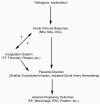Innate immunity, coagulation and placenta-related adverse pregnancy outcomes
- PMID: 19683334
- PMCID: PMC2788065
- DOI: 10.1016/j.thromres.2009.07.012
Innate immunity, coagulation and placenta-related adverse pregnancy outcomes
Abstract
Maternal immunity undergoes subtle adjustment in order to tolerate the semi-allogeneic embryo and maintain the host defense against potential pathogens. Concomitantly, coagulation systems change from an anti-coagulant state to a pro-coagulant state to meet the hemostatic challenge of placentation and delivery. Innate immunity and blood coagulation systems are the first line of defense to protect a host against exogenous challenges, including alloantigens and mechanical insults, and preserve the integrity of an organism. The interactions between coagulation and immune systems have been extensively studied. Immune cells play a pivotal role in the initiation of the coagulation cascade, whereas coagulation proteases display substantial immuno-modulatory effects. Upon exogenous challenges, the immune and coagulation systems are capable of potentiating each other leading to a vicious cycle. Natural killer (NK) cells, macrophages (Mphis) and dendritic cells (DCs) are three major innate immune cells that have been demonstrated to play essential roles in early pregnancy. However, immune maladaptation and hemostatic imbalance have been suggested to be responsible for adverse pregnant outcomes, such as preeclampsia (PE), miscarriage, recurrent spontaneous abortion (RSA) and intrauterine growth restriction (IUGR). In this review, we will summarize the mutual regulation between blood coagulation and innate immune systems as well as their roles in the maintenance of normal pregnancy and in the pathogenesis of adverse pregnancy outcomes.
Figures
Similar articles
-
The Role of Immune Cells in Recurrent Spontaneous Abortion.Reprod Sci. 2021 Dec;28(12):3303-3315. doi: 10.1007/s43032-021-00599-y. Epub 2021 Jun 8. Reprod Sci. 2021. PMID: 34101149 Free PMC article. Review.
-
The use and misuse of animal analog models of human pregnancy disorders.J Reprod Immunol. 2014 Jun;103:1-8. doi: 10.1016/j.jri.2014.02.006. Epub 2014 Mar 16. J Reprod Immunol. 2014. PMID: 24725995 Review.
-
Significance of inhibitory maternal killer-cell immunoglobulin-like receptor (KIR) and fetal KIR ligand genotype combinations in placenta related obstetric complications.J Reprod Immunol. 2021 Nov;148:103425. doi: 10.1016/j.jri.2021.103425. Epub 2021 Sep 21. J Reprod Immunol. 2021. PMID: 34607283
-
Innate Immune System at the Maternal-Fetal Interface: Mechanisms of Disease and Targets of Therapy in Pregnancy Syndromes.Am J Reprod Immunol. 2016 Oct;76(4):245-57. doi: 10.1111/aji.12509. Epub 2016 Apr 24. Am J Reprod Immunol. 2016. PMID: 27108670 Review.
-
The role of toll like receptors in pregnancy.Int J Fertil Steril. 2013 Oct;7(3):147-54. Epub 2013 Sep 18. Int J Fertil Steril. 2013. PMID: 24520479 Free PMC article. Review.
Cited by
-
Impact of Maternal Serotonin Transporter Genotype on Placental Serotonin, Fetal Forebrain Serotonin, and Neurodevelopment.Neuropsychopharmacology. 2017 Jan;42(2):427-436. doi: 10.1038/npp.2016.166. Epub 2016 Aug 23. Neuropsychopharmacology. 2017. PMID: 27550733 Free PMC article.
-
Association of the PECAM-1 (Leu125Val) and P-Selectin (Thr715Pro) Gene Polymorphisms With Unexplained Spontaneous Miscarriages.Cureus. 2022 Feb 3;14(2):e21859. doi: 10.7759/cureus.21859. eCollection 2022 Feb. Cureus. 2022. PMID: 35273840 Free PMC article.
-
Environmental impact on vascular development predicted by high-throughput screening.Environ Health Perspect. 2011 Nov;119(11):1596-603. doi: 10.1289/ehp.1103412. Epub 2011 Jul 25. Environ Health Perspect. 2011. PMID: 21788198 Free PMC article.
-
Relationship between common interleukin 1-beta gene polymorphisms and the risk of gestational disorders: An updated meta-analysis.Med J Islam Repub Iran. 2021 Feb 17;35:25. doi: 10.47176/mjiri.35.25. eCollection 2021. Med J Islam Repub Iran. 2021. PMID: 34169037 Free PMC article. Review.
-
Exploratory Evaluation of Circulating Microbiota-Derived Corisin Levels in Women with Adverse Pregnancy Outcomes.Antioxidants (Basel). 2025 May 31;14(6):670. doi: 10.3390/antiox14060670. Antioxidants (Basel). 2025. PMID: 40563304 Free PMC article.
References
-
- Gallucci S, Matzinger P. Danger signals: SOS to the immune system. Curr Opin Immunol. 2001;13:114–119. - PubMed
-
- Opal SM. Phylogenetic and functional relationships between coagulation and the innate immune response. Crit Care Med. 2000;28:S77–80. - PubMed
-
- Robertson SA, Redman CW, McCracken SA, Hunt JS, Dimitriadis E, Moffett-King A, Chamley L. Immune modulators of implantation and placental development--a workshop report. Placenta. 2003;24(Suppl A):S16–20. - PubMed
-
- Duley L. Maternal mortality associated with hypertensive disorders of pregnancy in Africa, Asia, Latin America and the Caribbean. Br J Obstet Gynaecol. 1992;99:547–553. - PubMed
-
- Challis JRG. Mechanism of parturition and preterm labor. Obstet Gynecol Surv. 2000;55:650–660. - PubMed
Publication types
MeSH terms
Grants and funding
LinkOut - more resources
Full Text Sources


